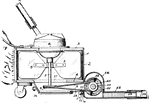Clipart tagged: ‘Vacuum’

Air Pump
"The air pump is an instrument for removing a gas from a closed vessel, the essential parts are shown."…
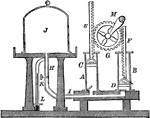
Double Barrel Air Pump
"Crank M raises and lowers the two pistons C and D. The valves allow only for air to be removed from…
Barometer
"A glass tube about 33 inches in length, open at one end, is completely filled with mercury, and being…
Barometer
"A cistern barometer, being that generally seen in weather-glasses or ordinary barometers. The tube…
Barometer
"Suppose a to be a long tube, with the piston b so nicely fitted to its inside, as to work air tight.…
Barometer
"Measures atmospheric pressure. Pressure from the atmosphere compresses the mercury in the tray forcing…
Barometer Measuring Pressure of a Partially Evacuated Vessel
"The degree to which the air has been exhausted from a closed vessel in which there is a partial vacuum…

Burst Bladder
A glass cylinder is open at the bottom, having a piece of bladder or thin indian-rubber tightly stretched…

Tantalus's Cup
"Whenever liquid reaches the bottom of the short leg on the siphon inside the cup, the liquid is discharged…

Savery's Engine
"Handle A opens and closes valves B and G. Steam is injected through pipe S which flushes any air/water…

Velocities of Falling Bodies
"When a feather and a cent are dropped from the same height, the cent reaches jthe ground first. this…
Two Objects Falling in a Vacuum
"Remove the air from a high glass tube by means of an instrument called the air-pump... Then... drop…
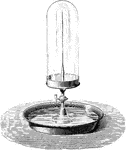
Fountain in Vacuo
This apparatus consists of a bell-shaped vessel of glass, the base of which is pierced by a tube fitted…

Foutain in Vacuo
"Draw out a piece of glass tubing to a jet, and push it through a perforation in a cork that snugly…

Radiant Heat
An example of radiant heat. "Radiant heat is transmitted in a vacuum as well as air." A thermometer…

Magdeburg Hemisphere
Two hemispheres which can be exactly fitted on each other; their exact adjustment is further assisted…

Magdeburg Hemispheres
"Grease the edges to make more sure of a tight joint, fit the hemispheres to each other, and exhaust…

Magdeburgh Hemispheres
"When placed together after the air has been taken out, it will take two very strong men to pull apart."…
Lifting Pump
"Liquid is pumped up through pipe A, through valve H. The airtight piston G allows the liquid to pass…

The Siphon
"A siphon is used to draw off liquids from a higher elevation to a lower one. The siphon uses the vacuum…
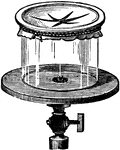
Vacuum
"Over the upper end of a cylindrical receiver, tie tightly a wet bladder or sheet of writing paper and…
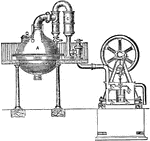
Vacuum-pan
"The vacuum-pan is in universal use in all European sugar-refineries, and in all well-provided sugar-plantations.…

